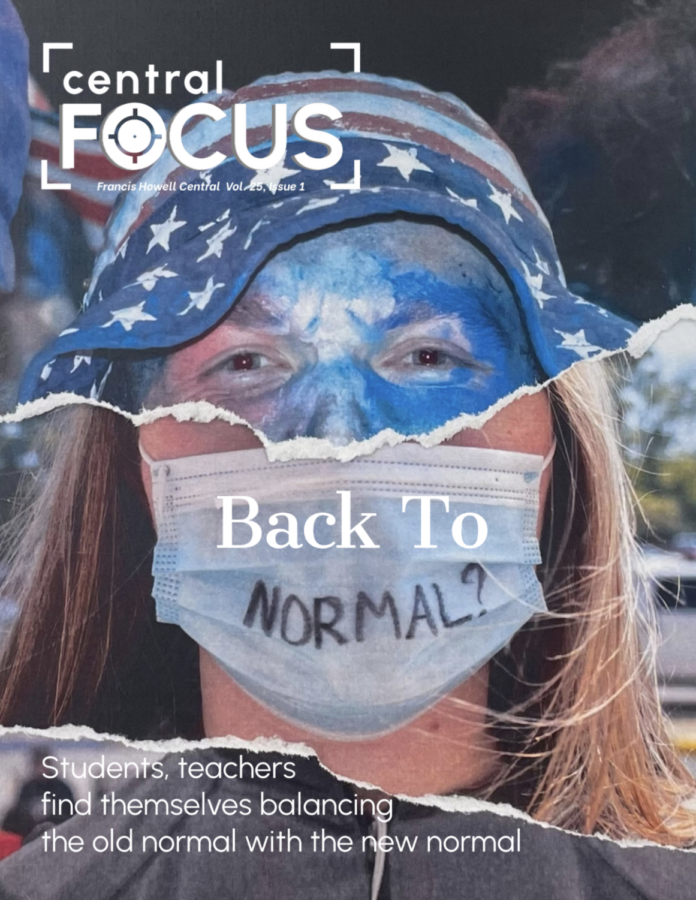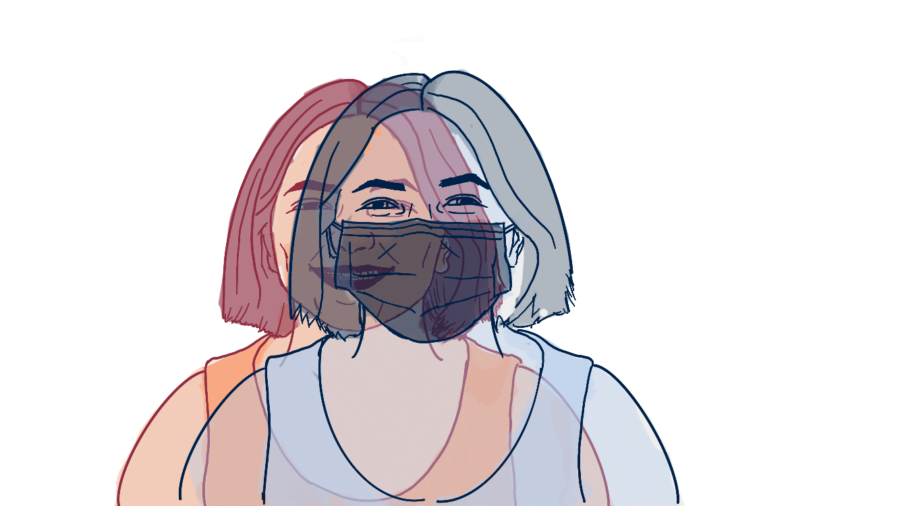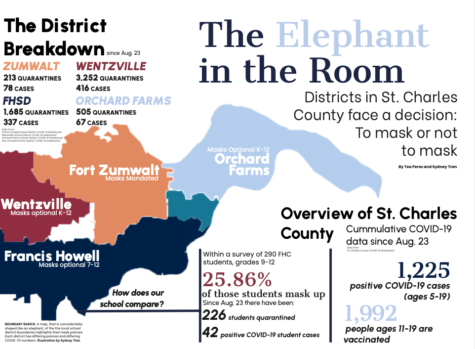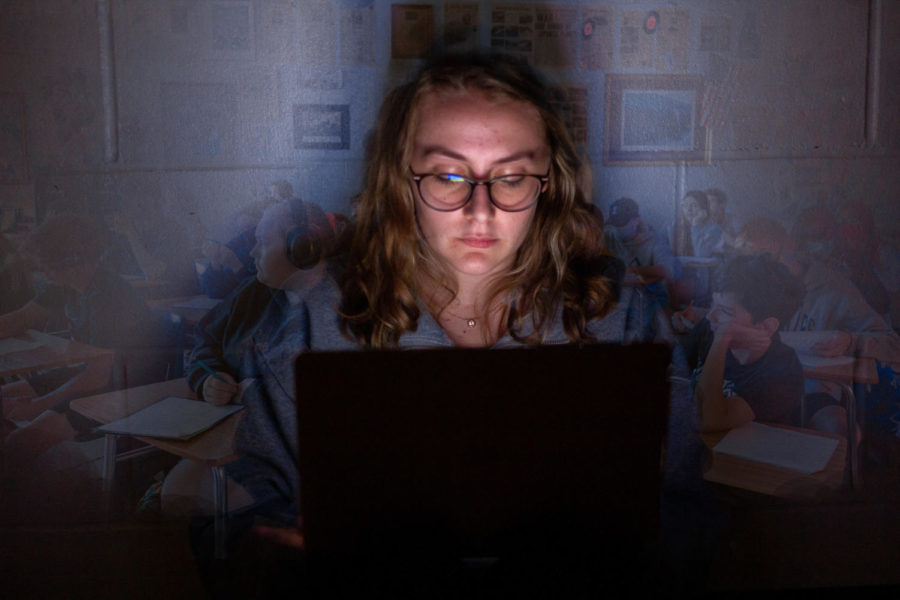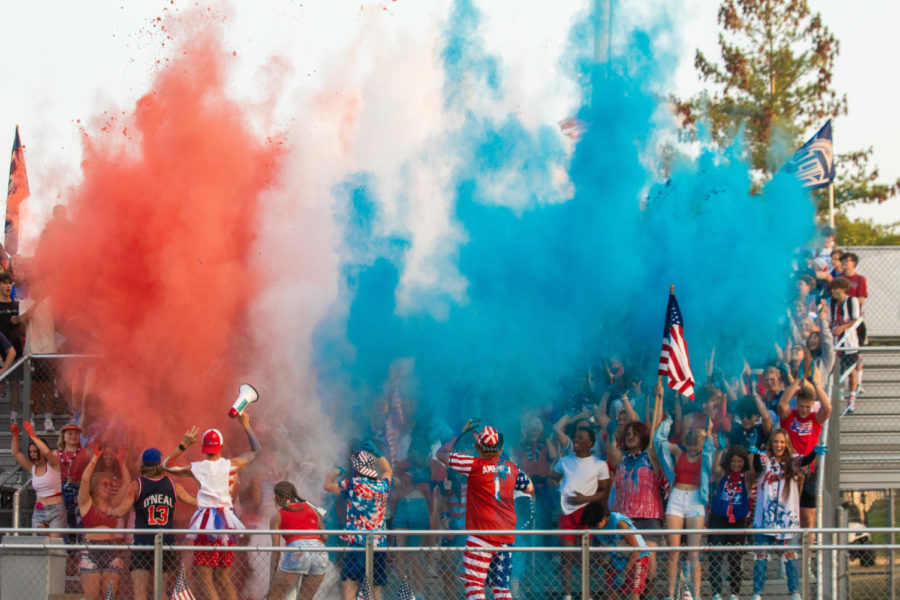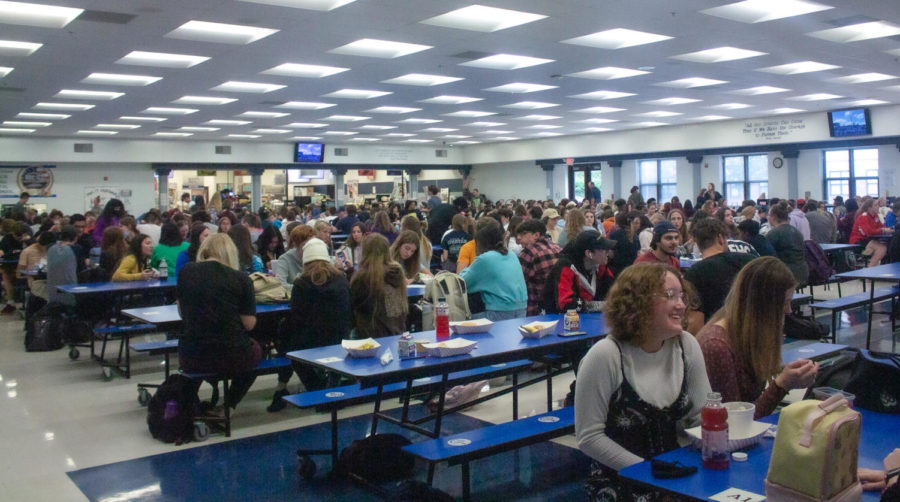Your donation will support the student journalists of Francis Howell Central High School. Your contribution will allow us to purchase equipment and cover our annual website hosting costs. FHCToday.com and our subsequent publications are dedicated to the students by the students. We hope you consider donating to allow us to continue our mission of a connected and well-informed student body.
Back To Normal?
Students, teachers find themselves balancing the old normal with the new normal
October 21, 2021
Seeing Double
Students and faculty adjust to seeing each other in a new perspective: without a mask
An illustration of a student wearing a mask and not wearing a mask overlaps each other. As students transition to not wearing masks, there is an added challenge of recognizing faces because last year only their eyes were visible.
The last two years have been nothing less than chaotic. Even though we have come back to school with COVID-19 calmed, it is still apparent that has been an adjustment. One adjustment that everyone can relate to is how strange it has been seeing people’s faces again or for the first time.
Returning to school with not only masks being optional, but with many more people in school as well, has been a transition for not only students, but teachers and faculty as well. This transition is something that can be described as strange for some people. For math teacher Dena Dauve, this is something she can agree with whole heartedly.
“For me, it is very strange, I know it makes a lot of people glad and happy. It just makes me feel worried because I want to keep everybody safe here,” Mrs. Duave said.
However, for others it’s a sign of a return to normalcy. Junior Dylan Hirth finds it strange that people had to wear masks to begin with.
“It is not strange because I have gone to school without a mask before and it feels normal again,” Hirth said. “Because it was strange coming to school with a mask, I don’t think it’s strange coming back without one.”
Seeing people’s faces again is not only strange but makes it harder to recognize people as well. Junior Hanna Lange has experienced the struggle of not being able to recognize people.
“Some people have come up to me and said ‘Hi Hanna’ and all I think is ‘I don’t know who you are,’” Lange said.
Mrs. Dauve comes from the other side of the spectrum, just being a person that is good with facial recognition she doesn’t struggle as much as others with recognizing students she’s only known behind a mask.
“I am big on facial recognition, I really like to put faces to names and I really like to imprint that,” Mrs. Dauve said. “So for me it is not hard, there have been a couple people that I look at and I get a little thrown off but then I just look at the eyes and I’m like ‘Oh it’s you.’”
With all of this change and transition happening it has made many question: is this the new normal or is normal a concept that is constantly changing? For Hirth it is the latter, not only because of everything evolving with COVID-19, but also because of today’s day and age and the changes happening with society.
“Normal is a concept that is changing because everybody is trying to normalize all different kinds of things nowadays other than what has been set by society,” Dylan said.
For Lange she believes that normal is not only constantly changing but also that how life now is considered to be the new temporary normal.
“Normal is a concept that is constantly changing but normal is also seeing some people wear masks, seeing some people who don’t,” Hanna said.
For Mrs. Dauve it is neither, she believes that what we consider normal is neither changing nor new. For Mrs. Dauve it is what life used to be.
“I think this feels so unnormal to us because we have never experienced anything like this in our lives. Do I feel like we will get back to what things were like pre-COVID? Yes. I don’t think this is our new normal,” Mrs. Dauve said. “Sure things ebb and flow and change, but I know that at some point in the near future things will look like they did pre-COVID. As far as what we consider normal, yes normal is what life was like pre-COVID.”
Transition to Traditional
Senior Lauren Sirtak walks into the school building, smiling at her friends and heading to her first hour Human Body Systems class. An involved student ready to enjoy all of the wonder and excitement of her senior year, Sirtak’s year looks incredibly different from her virtual junior year – as it does for all students returning to in-person school.
These students, who were virtual for over an entire school year between the original outbreak of COVID-19 and this August, visually blend in with the rest of the student body as they walk through the halls and sit in their classes. But their experience is anything but blended with that of their peers who spent last year in- building. While they didn’t have the sameconcerns with frequent quarantine or the sheer amount of potential exposure in the school setting, they experienced their own unique challenges – not the least of which was disconnection and isolation from their school community.
For Sirtak, this struggle of constant separation was a defining feature of her virtual junior year. Despite being a social person who loved being inside the school building, Sirtak made the decision to stay virtual for the 2020-2021 school year to protect a close family member who was immunocompromised.
“I was worried that I was going to catch [COVID-19], or I was going to be the one to give it to them and I didn’t want to be that person,” Sirtak said.
However, this decision came with a lot of sacrifice. Going from being incredibly involved in her school and outside community, Sirtak faced the very abrupt change of interacting with her peers only through small, black squares on a screen. This led to a development and worsening of depression for Sirtak, who admits that her isolation from others and the environment of online school had a very negative impact on her mental health.
“It was hard to stay in touch with people, so it was easy to just give in to not being as close with people anymore,” Sirtak said. “I definitely slept a lot more during the day and was more unmotivated to do schoolwork than I usually was.”
For Sirtak and her family, this was the biggest factor in her decision to come back. With her family feeling more safe and secure due to vaccinations, Sirtak was excited and ready to head back into school in August.
“It felt like a relief [to be in-person], like my life was finally unpaused again,” Sirtak said. “I’ve been waiting to come back since I left and now I’m back, it’s a relief.”
This excitement was shared by sophomore Xavier Hood. While involved in Marching Band and able to experience the school community throughout the first semester, Hood attended all of his classes virtually. Similar to Sirtak, Hood made the decision to stay home to protect himself and those around him from the spread of the virus. He also experienced the disconnection from his school community in his virtual classes.
“No one really talked, there were no cameras [kept on], there was no one really there,” Hood said. “It was just basically being by yourself in your room all day, every day, and it was just so different from the years before.”
Hood also notes that virtual learning made doing well in classes much harder, as he didn’t feel he had the same connection with teachers and students as in years past.
“My grades definitely dropped,” Hood said. “[Being back in-person] they have improved. It’s been a lot. I just learn a lot better without the distractions from being at home.”
The gaps in academic learning for virtual students are also something that has not gone unnoticed. Whether it’s due to gaps from virtual classes or simply from the prevalence of quarantines last year, it’s something math teacher Mrs. Brittany Williams says is evident in her classes. “You can definitely tell that there are some learning gaps, there are some things I’m used to my Algebra I students being able to do that they just can’t do,” Mrs. William said. “I think their transition socially has been okay, but there are just some gaps.”
The difference in the amount of work given and the amount of time to complete it is also a huge difference Mrs. Williams has noticed students have struggled to adjust to, as many of their teachers gave out less assignments or gave more time to complete them. Especially with the asynchronous days – days where students didn’t have to attend zoom class and used the school day to complete pre-assigned work.
“I do miss the asynchronous days, and I know a lot of the students coming back into in-person, they’re struggling with the workload because the workload is all of a sudden increased again,” Williams said.
Even for students who have been taking the academic and social shifts well, there are still other hurdles to jump. Coming in as a sophomore has been a challenge for Hood, who has experienced some of the typical freshman struggles as a sophomore new to the building. He notes that navigating the building was particularly difficult during the first two weeks.
“It was really confusing just trying to get around in such a big building. I got lost many times and had to ask teachers [for help]. I was late to classes, it was just so big,” Hood said.
However, while he did share some struggles with the Freshman, Hood wishes the school had been more mindful of the differences in the experiences between freshman and virtual sophomores when planning to help them adjust for the year, particularly at Transition Day. This year, the freshman and the sophomores who had been virtual attended the day together.
“It made it more difficult, because… I’ve seen some of the places just coming to school events during Freshman year. But then we were just spending the whole day going through things the Freshman have never seen,” Hood said. “I didn’t learn things about the school that would have been more important to me.”
Similarly, Sirtak wishes the school had made more of an effort to support students coming back virtually. Because so many students struggled with their mental health during their virtual year, she feels the school should have made more of an effort in the first several weeks to check in on student’s well-being during their transition back and make sure they were doing okay.
“I think [the school] probably should have… set time to talk to each of the virtual students to get them back and really be able to communicate with them how they’re doing,” Sirtak said. “Where they feel more comfortable to tell how they’re truly feeling, and they can go over some more extensive ways to bring a solution to that.”
However, there are many aspects of the transition that Sirtak has appreciated, such as being able to start fresh with new extracurricular involvement. Prior to the pandemic, Sirtak played softball and soccer for both FHC and select teams. This year, she has changed it up.
“I’m in girl’s golf this year and I’m in Central Outreach, HOSA, and NHS,” Sirtak said. “I like getting a new start, because it’s not going back to what it once was. It’s good to accept the changes that happened and it’s nice to get a new start on different activities and stuff like that.”
Despite the difficult year virtual students endured and the things students wished could have been changed, Sirtak believes everyone was doing the best they could in the middle of a difficult and unforeseen situation.
“It was definitely hard on all of us, including the school. I mean, although I think that they could have done a lot of things better, I get that it was new for everybody and sprung on everybody at once,” Sirtak said. “It wasn’t a good experience for many people, including myself, but I’m not holding a grudge against the school. It’s not their fault. It was an incident nobody could prevent and they tried their best, I think.”
Fans Never Left
Red, white, and blue powder is thrown up into the air in the student section at the red, white, and blue themed football game. There is a newfound sense of school spirit that shines through in the student section.
Painted bodies cram together in the student section. A cloud of colored powder is tossed above. Yell leaders call out cheers waiting for students to shout back. The new school year has brought back many old favorites, but for many FHC students, the return of Friday Night Lights has been the most important.
For many Spartans, FNL symbolizes what used to be. Friday evenings full of fun, friends, and football. By painting their faces and packing the student section, many chase the feeling of life pre-Covid. Yell Leader Luke Cummings has enjoyed the return of the student section this year.
“Things are getting better,” Cummings said. “We’re allowed to have these fans and we’re allowed to have these huge crowds … I think it’s back to normal.”
All Dine, No Dash
Switch to three lunches causes crowds, confusion
The cafeteria is full of students eating lunch and socializing with one another. The crowdedness of the cafeteria can be overwhelming for some students.
Walking into lunch this year students are met with the excited chattering and full tables of the crowded cafeteria. Due to last year’s COVID-19 restrictions, the school implemented five lunches, but this year we’re back to three. While the three-lunch schedule is what should have always been commonplace, the adjustment back has still been difficult. Junior Joseph Hornberger is one of many that see’s the difficulties in this switch.
“[The cafeteria is] just chaos,” Hornberger said. “Especially if you want to get into something along the lines of the deli, you’re going to be there for upwards of 10 minutes for one sandwich.”
The atmosphere of the cafeteria can sometimes be overwhelming for senior Kouper Campbell as well.
“It’s really crowded in [the cafeteria] and really loud, so it’s hard to hear people,” Campbell said.
Not only have the long lines and crowded kitchen been undesirable, but many students preferred the split lunch they got in the five lunch system.
“I had a split lunch so not only could I have a break mentally from my classes, but then when I got into a line I could go through it quickly, eat, and then check up on grades and my homework,” Hornberger said. “Now if I finish lunch by the time the bell rings, I’m lucky.”
To be able to have a break in the middle of class gave many students the opportunity to get a reprieve from the monotony of a full 50-minute class.
“[Split lunch] was nice because mine was in the middle of English, you would do [classwork] and then you got a break,” Campbell said. “[After lunch] you got to go back to that class and it was way quieter in there and you could just enjoy it more, it wasn’t so stressful.”

While students worry about getting in and out of the lunch lines with enough time to eat, the cafeteria staff are working to deal with the renewed influx of students coming through these lines. Cafeteria worker Heather Toebben works hard to make sure the flow of students stays consistent.
“I’ve been timing [how long it takes for students to get through the lines] […] I’ve been manually ringing some of the kids out to try to push them through, we’d like to keep [the wait] around seven or eight minutes,” Mrs. Toebben said.
The miscommunication within the lunch lines also add to the wait. Many students, especially freshmen, will simply go into a line without knowing what that line is for.
“A lot of times people see a line and go in and stand in them and they don’t realize there are other lines,” Mrs. Toebben said. “[I’ve had to ask students] if they’re in line for pasta or nachos and some will say yes, some will look confused and say no, and then you move them on.”
No matter the workload, the cafeteria staff does all they can to ensure each student who comes through is fed and has the proper energy to get them through the school day.
“Nutrition is a very important part of the learning process, [students] need that nutrition to focus and retain [information],” Mrs. Toebben said.
This task is taken extremely seriously by the lunchroom staff who are always available to assist anyone who may need help.
“We love what we do […] If students have questions, concerns, dietary needs, or anything like that they know to just reach out, that’s what we’re here for,” Toebben said.

